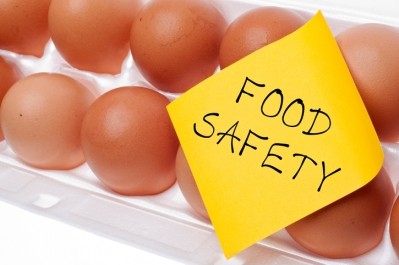Part one: Merieux Nutrisciences, Shimadzu, Agrolab and Fera
Fipronil scandal drives testing demand in chicken and egg-based products

Fipronil was detected in Dutch and Belgian farms prompting a recall of millions of eggs.
The issue has affected 15 European countries as well as Switzerland and Hong Kong.
Merieux Nutrisciences told us testing demand is for eggs and chicken meat as well as products where eggs are used as ingredient.
Shimadzu said it had seen a big interest on fipronil testing in Germany, Belgium and France.
Agrolab said it is receiving an average of 50-100 samples per day and before July 24 there was almost no demand for such analysis.
BfR
Taking the highest content measured in Belgium so far, 1.2 mg of fipronil / kg of eggs, a child weighing 16.15kg and an adult 65kg could consume 1.7 and seven eggs (70g) per day, respectively, without risk to health.
For eggs, European legislation sets the maximum residue level (MRL) in Regulation (EC) No 396/2005 at 0.005 mg/kg.
The European Food Safety Authority (EFSA) defined an Acute Reference Dose (ARfD) of 0.009 mg/kg body weight. ARfD refers to the maximum amount of a substance that can be ingested with no health hazard.
The European Commission proposed 0.72 mg/kg as the limit from which eggs contaminated with fipronil could present an acute health risk.
Levels up to 1.2 mg/kg have been detected in chicken eggs and meat in Belgium.
Raises attention to contaminants in general
Merieux Nutrisciences’ method is compliant with UNI EN 15662:2009.
The company said Fipronil and its metabolite fipronil sulfone are extracted with Quick, Easy, Cheap, Effective, Rugged and Safe (QuEChERS) method then tested by GC-MS/MS and LC-MS/MS.
More to come
The view of Sciex, Eurofins, SGS and others will feature in another article to be published soon. If you want to comment contact: joe.whitworth@wrbm.com
Samim Saner, scientific director at the firm, said there has been a significant increase in demand for fipronil testing in the last couple of weeks.
“The demand is not only for eggs but also for chicken meat and a wide range of products where eggs are used as ingredient. This increase is noticed mainly in Europe for the time being (all across Europe) but the demand outside Europe is also increasing since a few days.”
Saner said the crisis has hit many poultry farms, manufacturers and retailers and led to recalls across the value chain adding that direct costs and indirect impact (brand reputation) are severe.
“This crisis is linked with fipronil but raises more broadly the attention to contaminants in general, to composition and compliance of ingredients and auxiliary materials. Food manufacturing companies and retailers must include this in their risk analysis and quality management systems.
“An untargeted screening approach absolutely provides a unique tool to prevent similar incidents. By using untargeted screening approach we can find abnormalities or deviations from the normal fingerprint and discover new emerging contaminants that are normally not expected.”
Fipronil is an insecticide used to control fleas, cockroaches and ants but cannot be used for animals intended for the food chain, such as chickens.
Dutch authorities have identified 180 farms in which it was used since 1 January 2017.
The World Health Organization (WHO) has classified it as a moderately hazardous pesticide.
Fipronil contamination found more or less by accident
Dr Frank Mörsberger, senior group manager of food at Agrolab, said it applies HPLC MS/MS and sample preparation according to the QuEChERS method – an accredited process and is receiving an average of 50-100 samples per day.
“Before July 24 there was almost no demand for this analysis in food matrices, except for fruit and vegetables, grains and feed where the parameter is part of the common pesticide residue multi-methods. It started with fresh eggs,” he said.
“We already told our clients, that we expect an expansion to egg containing products, as the big majority of the eggs have not been sold as fresh eggs but for sure have found its way to the food production already in form of liquid egg and egg powders.
“Now we receive increasingly final products: from mayonnaise to chocolate and cookies. Also the feed industry is checking the protein sources for hidden eggs with fipronil residues.”
Dr Mörsberger said the closer you are to basic production (farmers, egg producers etc.) the lower the interest is to spend money for analytical services.
“Only mandatory analysis is ordered or if quality checks on behalf of buyers have to be fulfilled. This shows the other side, which is characterised by the big retailers. These companies are afraid of reading their names in newspaper headlines and spend their own money or force their suppliers to control their products regularly and in most cases based on a risk assessment,” he said.
“None of these groups had the idea to check any eggs for fipronil contamination. The supermarkets ask for testing of what seems reasonable. Nobody can blame them for not having thought of such a manipulation.
“The public health authorities have found fipronil more or less by accident - like in previous cases too. The European bureaucracy and national thinking still hinder a fast and preventive communication.”
Dr Mörsberger said he strongly supported non-targeted analysis as one of the analytical approaches in the future but the problem is who will pay for it.
“The governmental control has neither the technical possibilities, nor the personnel to follow this approach in depth and the private labs, who might spend money, have to see the return on investment. There is no market for it yet, this is the problem.
“The industry is not really interested in revealing any new “problems”, which might cause trouble. However, there are already a few exceptions. I know about two big international food groups, who just started with non-targeted analysis in residue analysis.”
People are tired of food scandals
Uwe Oppermann, manager food market of Shimadzu Europa, said it has developed an application package for determination of fipronil and other plant protection products (pesticides/insecticides) with a QuEChERS method for sample preparation with an additional dispersive Solid Phase Extraction (dSPE) step.
The system configuration can be GC-MS/MS or LC-MS/MS method based on the Shimadzu Nexera X2 UHPLC system with LCMS-8060 triple quadrupole mass spectrometer.
“The time requirement for measuring one sample of egg/or meat takes four minutes on the Shimadzu system configuration and the Limit of Quantification for fipronil is 0.001µg/kg.”
Oppermann said it has seen a big interest for testing in countries like Germany, Belgium and France.
“Fipronil was not expected in food, as many other substances like mycotoxins and heavy metals. There is only one way for companies to protect their brand - that is continuous control.”
Strict and steady control of food and packaging is needed, said Oppermann.
“People are really tired of food scandals such as the contaminations with MOSH/MOAH, heavy metals, and now the fipronil. The packages for Shimadzu LC-MS/MS systems include more than 600 pesticides in order to be prepared for pesticide residues in femtogram level.”
Sadat Nawaz, a Fera pesticide expert, said it plays a role in limiting risk by detecting pesticides in food.
“Fera Science, a joint venture between Capita and Defra, is a first responder to emerging food safety issues. Fera routinely tests for fipronil and its metabolites in fruit and vegetable samples with an accredited technique it devised years ago.
“This insecticide has, very recently, been detected in eggs in the Netherlands causing a public safety risk, so we immediately adapted and validated our existing technique to test fipronil in eggs, helping the food industry and regulatory bodies control this risk and take the necessary steps to protect and reassure the public.”
Fera is the UK’s National Reference laboratory for analysis of pesticides residues.




















